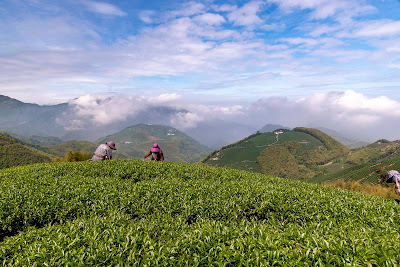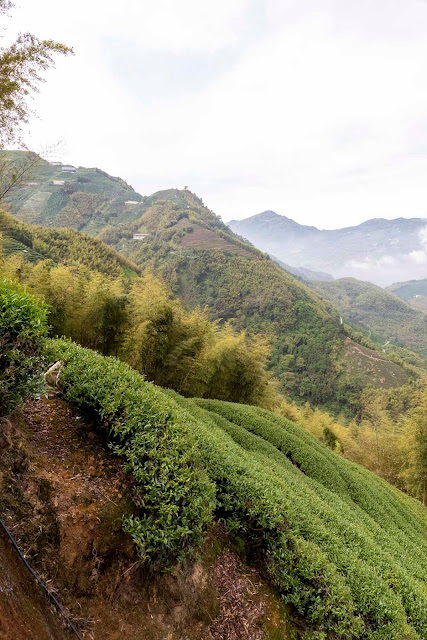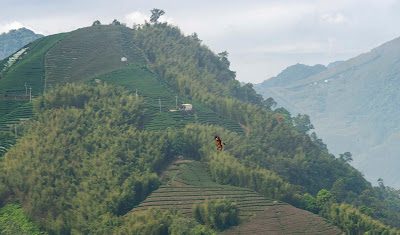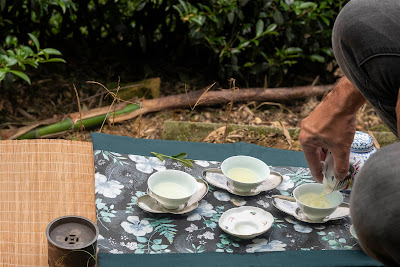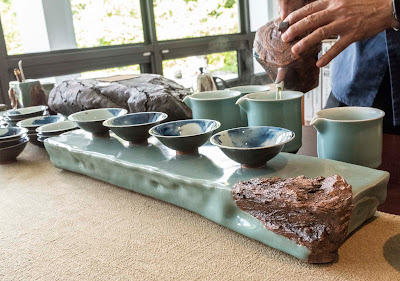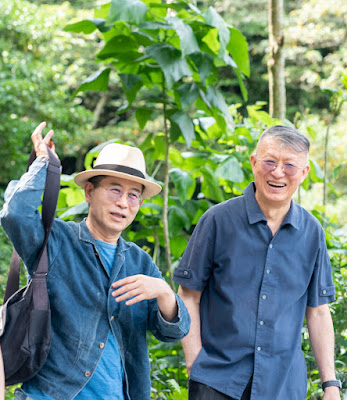Friday, May 26, 2023
Le vertige à Shan Lin Xi Oolong du printemps 2023
Je vous rassure tout de suite, je n'ai pas été pris de vertiges dans les plantations de haute montagne! Ce n'est pas faute d'être intoxiqué par l'air frais et un peu raréfié à plus de 1300 mètres d'altitude. L'ascension en voiture est relativement aisée si l'on excepte les 500 derniers mètres sur une route à peine plus large qu'une voiture! Non, le plus dur, c'est de gravir les pentes escarpées de la plantation. C'est parfois très raide! Le soleil tape, les pieds dérapent sur un sol meuble et les théiers ne laissent presque pas de place entre eux pour marcher! Telles sont les conditions de travail des courageuses cueilleuses (et quelques cueilleurs) de Oolong de haute montagne. Il faut s'en souvenir quand on veut pleinement apprécier les saveurs de ce thé de Shan Lin Xi. Cette cueillette manuelle, munie de fins rasoirs, est l'un des secrets du goût tout en douceur de ces Oolongs de haute montagne. En préservant l'intégrité de la feuille au maximum, on évite qu'elle ne s'oxyde de manière incontrôlée et qu'elle perde ses sucs. Les récoltes mécaniques ont des saveurs astringentes et amères très prononcées en comparaison. C'est pourquoi la récolte manuelle s'est imposée pour les Oolongs de première qualité.
Mais ce n'est qu'un facteur de réussite du thé! Il y a tant d'autres facteurs qui vont influencer la qualité des récoltes: la météo, c'est à dire ce mix de températures, d'ensoleillement et de précipitations! Et puis il s'agit aussi de bien les transformer. Or, le processus de transformation du Oolong est le complexe qui soit! En effet, le degré d'oxydation va différer d'un batch à l'autre et d'un producteur à l'autre. Puis vient la grande question de la torréfaction. Souvent, elle est minimale pour les Oolongs de haute montagne. Il s'agit de ne pas prendre de risque qui affecterait les saveurs les plus fraiches. Mais ne pas prendre ce risque, c'est prendre celui d'avoir des feuilles trop humides qui peuvent s'oxyder et décliner avec le temps!
Il est là le vertige du producteur et du sélectionneur de Oolong de haute montagne. Il y a tant de facteurs qui influencent la qualité des feuilles! La recherche de la perfection a autant de chance d'aboutir que la recherche du Graal! Cela ne nous empêche pas d'essayer! Ce weekend, je vous parlerai justement de la qualité des récoltes d'Ali Shan et de Shan Lin Xi ce printemps. Si vous ne pouvez suivre le direct dimanche matin à 10h, c'est dommage, car je réponds à vos questions en direct! Mais vous pourrez voir l'émission un peu plus tard sur ma chaine YouTube.
Thursday, May 18, 2023
Shan Lin Xi Oolong, spring 2023
The harvest of this Shan Lin Xi plantation starts at 6:30 AM. The weather is usually drier in the morning than in the afternoon, so it makes sense to start early and pick as many leaves as possible before the fog comes with its moisture.
This year, the harvest in this plantation was delayed by a week to May 10th, because of the dry and cool weather. And while usually the harvest takes place on two or three consecutive days, this year, the second harvest day was 6 days after the first, because the leaves still needed to grow! It's only in some parts of the plantation that they were deemed big enough for a harvest on May 10th.
This farmer loves his high mountain Oolong fine and concentrated. That's why he didn't hesitate to take a risk and harvest his field earlier than others. That's why this year's batch includes smaller leaves than usual. This means more power and aftertaste.
But the lack of rain and irrigation also means that the leaves have grown very unevenly this year. Their appearance isn't very appealing if you like you leaves with the same size. However, I feel that this unevenness adds to the natural feel of Oolong tea this year. It's like on a farmer's market: the vegetables come in various sizes and shapes, unlike in the supermarket. These vegetables have more taste and flavor than those neat looking mass produced carrots or tomatoes! The situation is similar with this family owned plantation. The real quality isn't seen on the outside, but felt when it's inside!
2 years ago, I wrote an article inspired by Sinatra's 'Come fly with me to the moon'. I mentioned that the pictures from this mountain look as if we were flying, as if we had an eagle eye! And guess what?! Today I saw an eagle flying over the plantation! Beautiful!
Walking up and down in the sun is difficult. It's even more difficult when you have to pick up lots of tea leaves and carry a big basket to hold them! But hand picking is essential to achieve the highest quality and the sweetest taste!
What is amazing is the smell of the dry leaves. They exude lavender fragrances and pine mountain fragrances very similar to those I smelled in the plantation. Tea is really a excellent absorber and transmitter of fragrances!
After my tour of the plantation, it's time for some tea in the plantation! The weather is already started to become more foggy!
I found a spot where I could put a spring Shan Lin Xi Chaxi. I boiled mineral water in my silver kettle and brewed the 2023 spring Shan Lin Xi Oolong.
I wasn't in a very comfortable position, but it was totally worth it! Perfect harmony of tea, place and man! And I was even able to share a cup with the son of the farmer who came along to help!
Not everyone has the chance of coming to Taiwan and even fewer get to drink Oolong tea in the high mountains. But with my selection of high mountain Oolongs, I'm your help to obtaining some of the finest and freshest leaves from Taiwan!
The quality of this year's Shan Lin Xi is outstanding and reminds me of DaYuLing for its power. Cheers!
This year, the harvest in this plantation was delayed by a week to May 10th, because of the dry and cool weather. And while usually the harvest takes place on two or three consecutive days, this year, the second harvest day was 6 days after the first, because the leaves still needed to grow! It's only in some parts of the plantation that they were deemed big enough for a harvest on May 10th.
This farmer loves his high mountain Oolong fine and concentrated. That's why he didn't hesitate to take a risk and harvest his field earlier than others. That's why this year's batch includes smaller leaves than usual. This means more power and aftertaste.
But the lack of rain and irrigation also means that the leaves have grown very unevenly this year. Their appearance isn't very appealing if you like you leaves with the same size. However, I feel that this unevenness adds to the natural feel of Oolong tea this year. It's like on a farmer's market: the vegetables come in various sizes and shapes, unlike in the supermarket. These vegetables have more taste and flavor than those neat looking mass produced carrots or tomatoes! The situation is similar with this family owned plantation. The real quality isn't seen on the outside, but felt when it's inside!
2 years ago, I wrote an article inspired by Sinatra's 'Come fly with me to the moon'. I mentioned that the pictures from this mountain look as if we were flying, as if we had an eagle eye! And guess what?! Today I saw an eagle flying over the plantation! Beautiful!
Walking up and down in the sun is difficult. It's even more difficult when you have to pick up lots of tea leaves and carry a big basket to hold them! But hand picking is essential to achieve the highest quality and the sweetest taste!
What is amazing is the smell of the dry leaves. They exude lavender fragrances and pine mountain fragrances very similar to those I smelled in the plantation. Tea is really a excellent absorber and transmitter of fragrances!
After my tour of the plantation, it's time for some tea in the plantation! The weather is already started to become more foggy!
I found a spot where I could put a spring Shan Lin Xi Chaxi. I boiled mineral water in my silver kettle and brewed the 2023 spring Shan Lin Xi Oolong.
I wasn't in a very comfortable position, but it was totally worth it! Perfect harmony of tea, place and man! And I was even able to share a cup with the son of the farmer who came along to help!
Not everyone has the chance of coming to Taiwan and even fewer get to drink Oolong tea in the high mountains. But with my selection of high mountain Oolongs, I'm your help to obtaining some of the finest and freshest leaves from Taiwan!
The quality of this year's Shan Lin Xi is outstanding and reminds me of DaYuLing for its power. Cheers!
Friday, May 12, 2023
Les 5 Chaxi des 2 vallées
Nous êtions très heureux que M. Lin Chen-Long nous prépare du thé avec les accessoires qu'il a créé lors de notre visite (voir l'article précédent). Mais Teaparker ne voulait pas que nous venions les mains vides. Et comme il y a un superbe jardin devant la galerie de ce céramiste Taiwanais, chacune de ses classes a disposé un Chaxi! Voyez les trésors de créativité et d'harmonie que les élèves de Teaparker ont démontré:

Ci-dessous, je tiens quelques feuilles à la main pour la décoration du Chaxi de mon groupe.
Ce Chaxi bénéficie de la hauteur d'une large pierre. C'est le troisième Chaxi à utiliser un obi, une ceinture de kimono japonais comme Chabu.
Si le prochain Chaxi apparait un peu plus modeste et dépouillé (par rapport aux autres), ce n'est pas tant parce que c'est la création d'un jeune homme, mais car c'est un des élèves avec l'ancienneté la plus courte.
Je me rappelle qu'il a infusé un Oolong de haute montagne dans sa théière en zhuni d'Yixing.
Ci-dessous, j'aime bien la simplicité du Chaxi. Je reconnais la jarre de la dynastie Ming. Elle contient du Oolong parfumé aux fleurs d'orchidée qui sera infusé dans une théière en argent. On notera aussi une bouilloire en poterie et un Nilu au charbon de bois pour bouillir l'eau. J'aime bien la disposition des fougères: elles suivent la courbe des coupes! Le Jianshui (pour eaux usées) en étain est très classe aussi!
Mais revenons au Chaxi de mon groupe. Là aussi nous utilisons un long Nilu pour chauffer une bouilloire en argent avec du charbon de bois. La grande théière duanni d'Yixing fut réalisée pour l'export vers la Thailande. Ses particularités sont son polissage qui la rend brillante et l'ajout d'une poigné en cuivre.Chacun de nos Chaxi a son 'menu'. Il comprend la liste des accessoires utilisés, lenom du thé infusé, ainsi qu'un nom poétique. Et le tout est imprimé sur un joli papier. Ainsi, on laisse une trace physique de l'événement.
J'ai réussi à faire tenir les feuilles glanées dans le jardin dans une petite coupe que la céramiste suisse Geneviève Meylan m'avait offerte il y a quelques années!
Teaparker vient nous rejoindre pour la photo souvenir.
Puis ce fut le moment où M. Lin et sa femme se joignirent à nous et goûtèrent à ma tarte au pomme alsacienne. Je peux dire qu'elle a fait honneur à notre gastronomie!
Il fallait bien une grande théière pour désaltérer tant de monde par une après-midi déjà chaude et moite!
Le clou du spectacle de ce jardin fut cet arbre rempli de feuilles blanches de 'tonghua' (elles ressemblent un peu aux aubépines) qui fleurissent en mai dans les forêts du nord de Taiwan. J'en ramassai plusieurs dizaines et en décorai l'herbe devant le Chaxi.
La fleur fanée de tonghua nous rappelle notre mortalité. Profitons bien tous de ce nouveau printemps et utilisons nos plus beaux accessoires pour déguster nos thés préférés!
D'ailleurs, je serai en vadrouille ce weekend pour les récoltes de Shan Lin Xi. Nous nous retrouverons donc dimanche prochain pour le prochain cours de thé.
Wednesday, May 10, 2023
Taiwan Ceramic artist Lin Chen-Long
Last Saturday, I had the privilege to meet Lin Chen-Long, a famous Taiwanese ceramic artist who lives and works in the mountains south of Tucheng (in New Taipei City). The very first thing he did was brewing some tea in his tea pot, on the tea tray he fired and then pouring the tea in the pitchers and cups he made! This is the kind of ceramic artist we appreciate most: he's not just making abstract art, but also tea ware that he's using in his everyday life!
Lin Chen-Long was born in 1955 in Lugu, the town that is holding the Dong Ding Oolong competition. So, it's not a surprise that he would create so much tea ware! That day, he prepare a zhuoyan (jassid bitten) Oolong in his teapot and this is how it looked in his qinghua cup.
Teaparker organized this meeting for his tea students that day.
Here we are listening to M. Lin's presentation of his career.He started at a pottery at a young age, his parents too poor to send him to university. But he loved creating shapes from mud so much that it quickly became his passion. In the early years, he was doing a lot of imitation of antique potteries, like Tang tri-color horses.
He was starting from scratch and had to learn a lot from artists and other potters. Below, we can see that he met with the most famous Yixing artist Gu Jingzhou (1915-1996) when he visited China in 1992.These are all the tools that a zisha teapot maker may use to make a teapot. M. Lin was quite amazed by the level of skill that was required to make an Yixing teapot!M. Lin was also fascinated by the use of large containers that enable potters to keep their wares wet for months, so that they may continue to work on them as it pleases them.In his learning period, M. Lin Chen-Long also invited countless famous artists to cooperate with him. They would paint on ceramics he would create for their works. This enabled him to meet and interact with many painters, calligraphers and poets. M. Lin gave them a new medium (ceramics) to express their art and he was able to see their creative process at work.
The next vase shows that M. Lin had achieved a good command of various porcelain styles: celadon, qinghua, cracked (ge) and red.Then came M. Lin started to be creative on his own and one of his first theme was inspired by a walk near a water reservoir. He noticed the beautiful, calm, green water surface next to eroded stones. And this has inspired lots of works. Here a detail that catches the contrast:And here is the whole piece, framed like a painting, even though it's a ceramic! Indeed, it can be enjoyed like a painting, at different levels. The bluish green celadon is very calming to watch. The barren soil creates unease, but it's not worthless. There are a few gold spots! Hope?
The next vase continues this coexistence of cracked pottery and cracked qinghua (underglazed blue on white) porcelain. It is quite a bold statement to make cracks such a central piece of one's work for a ceramist. After all, a crack is the imperfection that every potter fears and strives to avoid. So, it's a powerful symbol of humility. The coexistence of different textures, colors while still achieving harmony is also full of positive meaning.
The next vase continues to explore these cracks that connect different colors. This one pays homage to Ge (or Ko) ware, a cracked white style from the Sung dynasty (960-1276).Then M. Lin also created works in the shape of books in a theme called 'clean (pure) soil pottery books'. He would again mix several techniques on the same work. Here, we have the clean celadon surface with a pottery that looks as if a stone had somehow grown on the book.
Instead of having cracks, we have layers of soil, like in a river that has run partially dry. Here, the celadon is the white page and the rock the content that we must read. And despite their differences, the combination of both textures and colors works well to achieve harmony and meaning.
The next work is again based on cracks and is from the Clay Land Series (I think, based on other similar works features in the magazine that features M. Lin next):This magazine was published for celebration of the 100 years of the Republic of China (in 2011): 100 years Taiwan artists, Lin Chen-Long, 2 valleys.The abstract work on the cover is, like the one below, from the Space/Glazing series. The fine round tubes are tricky to fire. This kind of new work required that M. Lin Chen-Long continued to innovate to make it stand. This time, the concepts of space and interconnections are at the center of these works. But what about the tea cups on top of the tubular structure?
My personal explanation would be that the tea cup is the highest pursuit in life. The tea cup is the crown achievement of a day, as it combines water, fire (to heat), leaf and soil (for the teaware). The explanation that M. Lin suggested is similar: he wanted to add an element that would symbolize his (Chinese) culture. The tea cup (without handle) or the tea bowl are great symbols, according to him, and their harmonious shape and color variations enable him to be very creative in choosing the right cup for each work.Lin Chen-Long is working on a new interesting project. Let's step out of his gallery, enjoy the view of his garden on top of 2 valleys (hence the name of his ceramic studio) and take a right turn along a small path in the forest to his studio. We arrive at his gas kiln, ready to fire the next artwork. We also notice this big machine. It's a stone and rock grinder. It turns hard clay/stones into powder, so that it can be mixed with water and become a humid clay that can be shaped.In the background you can see works from previous periods, but what M. Lin is holding is part of his latest creations. He's showing us how stones evolve when fired in his kiln. The 2 stones he's holding are actually the same, but in his right hand it has been fired at about 1180 degrees Celsius in his kiln. It now looks inflated, very cracked and like cold lava.
You can see these two stones more clearly below. M. Lin explains that each stone will react differently in the kiln. For some the change is radical. for fossil tree stones, however, the heat makes no difference. But when we look at these natural cracks, we can understand that M. Lin would be so fascinated by them. They resonate with his early works.So, Lin Chen-Long has now combined these "fired stones" into his Space series. The contrast between the rectangular shape of the celadon and the free shape of the stone creates maximum drama.And he's also using the stones on their own with ceramics on top and on parts of the stone.This one looks like a mountain with gold and celadon that add contrast of colors and surface.
So, I was very glad to have met this ceramist who is acclaimed on both sides of the straits. And I brought a little French thing that I fired around 210 degrees Celsius in my oven: an apple pie!
Lin Chen-Long was born in 1955 in Lugu, the town that is holding the Dong Ding Oolong competition. So, it's not a surprise that he would create so much tea ware! That day, he prepare a zhuoyan (jassid bitten) Oolong in his teapot and this is how it looked in his qinghua cup.
Teaparker organized this meeting for his tea students that day.
Here we are listening to M. Lin's presentation of his career.He started at a pottery at a young age, his parents too poor to send him to university. But he loved creating shapes from mud so much that it quickly became his passion. In the early years, he was doing a lot of imitation of antique potteries, like Tang tri-color horses.
 |
| Lin Chen-Long is in the middle |
The next vase shows that M. Lin had achieved a good command of various porcelain styles: celadon, qinghua, cracked (ge) and red.Then came M. Lin started to be creative on his own and one of his first theme was inspired by a walk near a water reservoir. He noticed the beautiful, calm, green water surface next to eroded stones. And this has inspired lots of works. Here a detail that catches the contrast:And here is the whole piece, framed like a painting, even though it's a ceramic! Indeed, it can be enjoyed like a painting, at different levels. The bluish green celadon is very calming to watch. The barren soil creates unease, but it's not worthless. There are a few gold spots! Hope?
The next vase continues this coexistence of cracked pottery and cracked qinghua (underglazed blue on white) porcelain. It is quite a bold statement to make cracks such a central piece of one's work for a ceramist. After all, a crack is the imperfection that every potter fears and strives to avoid. So, it's a powerful symbol of humility. The coexistence of different textures, colors while still achieving harmony is also full of positive meaning.
The next vase continues to explore these cracks that connect different colors. This one pays homage to Ge (or Ko) ware, a cracked white style from the Sung dynasty (960-1276).Then M. Lin also created works in the shape of books in a theme called 'clean (pure) soil pottery books'. He would again mix several techniques on the same work. Here, we have the clean celadon surface with a pottery that looks as if a stone had somehow grown on the book.
Instead of having cracks, we have layers of soil, like in a river that has run partially dry. Here, the celadon is the white page and the rock the content that we must read. And despite their differences, the combination of both textures and colors works well to achieve harmony and meaning.
The next work is again based on cracks and is from the Clay Land Series (I think, based on other similar works features in the magazine that features M. Lin next):This magazine was published for celebration of the 100 years of the Republic of China (in 2011): 100 years Taiwan artists, Lin Chen-Long, 2 valleys.The abstract work on the cover is, like the one below, from the Space/Glazing series. The fine round tubes are tricky to fire. This kind of new work required that M. Lin Chen-Long continued to innovate to make it stand. This time, the concepts of space and interconnections are at the center of these works. But what about the tea cups on top of the tubular structure?
My personal explanation would be that the tea cup is the highest pursuit in life. The tea cup is the crown achievement of a day, as it combines water, fire (to heat), leaf and soil (for the teaware). The explanation that M. Lin suggested is similar: he wanted to add an element that would symbolize his (Chinese) culture. The tea cup (without handle) or the tea bowl are great symbols, according to him, and their harmonious shape and color variations enable him to be very creative in choosing the right cup for each work.Lin Chen-Long is working on a new interesting project. Let's step out of his gallery, enjoy the view of his garden on top of 2 valleys (hence the name of his ceramic studio) and take a right turn along a small path in the forest to his studio. We arrive at his gas kiln, ready to fire the next artwork. We also notice this big machine. It's a stone and rock grinder. It turns hard clay/stones into powder, so that it can be mixed with water and become a humid clay that can be shaped.In the background you can see works from previous periods, but what M. Lin is holding is part of his latest creations. He's showing us how stones evolve when fired in his kiln. The 2 stones he's holding are actually the same, but in his right hand it has been fired at about 1180 degrees Celsius in his kiln. It now looks inflated, very cracked and like cold lava.
You can see these two stones more clearly below. M. Lin explains that each stone will react differently in the kiln. For some the change is radical. for fossil tree stones, however, the heat makes no difference. But when we look at these natural cracks, we can understand that M. Lin would be so fascinated by them. They resonate with his early works.So, Lin Chen-Long has now combined these "fired stones" into his Space series. The contrast between the rectangular shape of the celadon and the free shape of the stone creates maximum drama.And he's also using the stones on their own with ceramics on top and on parts of the stone.This one looks like a mountain with gold and celadon that add contrast of colors and surface.
The next piece reminds me a little bit of the martial arts poses sculpted in stone by Ju Ming, another Taiwanese artist who died very recently (on April 22nd, 2023) were it not for the celadon cup on top.
The more the master refines his art, the lighter seems his touch. He has found to express the roughness of nature in a harmonious way. And even the thick celadon clay feels very natural and linked to the very origin of Chinese ceramics.
M. Lin's exhibition at the Yixing ceramic museum in China was interrupted by the start of Covid, but he's been re-invited to go there and he will bring new works that he has created with Yixing clay he got from his earlier trip there.
 |
| M. Lin Chen-Long, Teaparker and Stéphane Erler |
The heat/fire helps to transform clay, stones and dough into something with a new consistency and new harmony! Thanks for your exploration of all these possibilities, M. Lin! It was a pleasure meeting you and enjoying a tea party with many of Teaparker's students next to your studio!
Announcement for tea drinkers: The spring 2023 harvests of Wenshan Baozhong and high mountain Oolong (3 Alishan, so far) are already available on my online boutique! Every purchase you make supports my blog and my endeavors to share Taiwan and China's tea culture with the Western worlds. Thank you!!
Announcement for tea drinkers: The spring 2023 harvests of Wenshan Baozhong and high mountain Oolong (3 Alishan, so far) are already available on my online boutique! Every purchase you make supports my blog and my endeavors to share Taiwan and China's tea culture with the Western worlds. Thank you!!
Subscribe to:
Comments (Atom)







